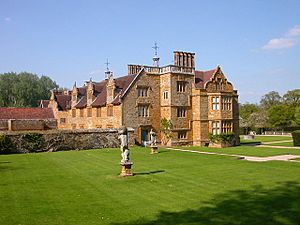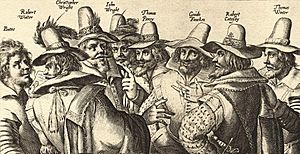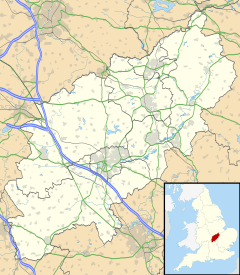Ashby St Ledgers facts for kids
Quick facts for kids Ashby St Ledgers |
|
|---|---|
 The manor house where the Gunpowder Plot was reportedly planned |
|
| Population | 173 (2011 Census) |
| OS grid reference | SP5768 |
| • London | 78 miles (126 km) |
| Unitary authority |
|
| Ceremonial county | |
| Region | |
| Country | England |
| Sovereign state | United Kingdom |
| Post town | RUGBY |
| Postcode district | CV23 |
| Dialling code | 01788 |
| Police | Northamptonshire |
| Fire | Northamptonshire |
| Ambulance | East Midlands |
| EU Parliament | East Midlands |
| UK Parliament |
|
Ashby St Ledgers is a small village located in the West Northamptonshire area of Northamptonshire, England. It's close to the town of Rugby in Warwickshire. In 2011, about 173 people lived in the village. The Manor House in Ashby St Ledgers is well-known because it was a secret meeting place for those who planned the Gunpowder Plot in 1605. Today, the historic property has been restored and can even be rented.
Contents
Where is Ashby St Ledgers?
The village is about 5 miles (8.0 km) northwest of Rugby. It's also about 3 miles (4.8 km) south of Daventry. The old Roman road, Watling Street (now the A5 road), runs about a mile to the east.
If you want to travel by train, the closest station is in Rugby. From there, you can catch trains to London Euston and other parts of the country. The village is also near the M1 motorway, which connects London to Yorkshire.
History of the Village
Ashby St Ledgers was first mentioned in the Domesday Book. This was a big survey of England completed in 1086. Back then, the village was called "Ascebi," which means "ash tree settlement."
Later, during Norman times, a church was built here. It was named after Saint Leodegarius. This is where the "St Ledgers" part of the village's name comes from today.
Important Buildings
The Manor House
The manor of Ashby St Ledgers was first given to Hugh de Grandmesnil by William the Conqueror. Over time, it was owned by different families. In 1375, it became the main home of the Catesby family.
One famous member of this family was Robert Catesby. His father, Sir William Catesby, managed to keep the property. This was despite having many debts and being jailed for his strong Roman Catholic faith.

The manor's location was handy for the Catesbys' many friends and family. This made Ashby St Ledgers a sort of "command center" for planning the Gunpowder Plot. It's believed that Robert Catesby, his helper Thomas Bates, and other plotters met in a room above the Gatehouse. This room was private and had a clear view of the area. Here, they planned many details of the Gunpowder Plot.
After the plot failed, Robert Catesby was killed. His helper, Thomas Bates, was later executed. The manor was taken by the Crown because Catesby was seen as a traitor. However, Robert Catesby's wife, Lady Anne Catesby, had rights to a large part of the property. This helped save some of the estate.
In 1612, Bryan I'Anson bought the manor. His son, Sir Bryan I'Anson, became a Gentleman of the Bedchamber to Charles I of England. Later, in 1703, the manor was sold to Joseph Ashley. It stayed in his family until 1903. Then, Ivor Guest, 1st Viscount Wimborne, who had been renting it for hunting, bought it.
Viscount Wimborne's grandson, Ivor Guest, 3rd Viscount Wimborne, sold the estate in 1976. It was owned by several different groups, including the British Airways Pension Fund. They separated the manor house from the rest of the estate. In 1998, the 3rd Viscount's son, Ivor Guest, 4th Viscount Wimborne, bought the house back. It was in bad shape, but he spent two years restoring it. Later, his cousin, Henry Guest, and his wife Nova bought it.
The original medieval manor house changed a lot over time. The Catesbys added new parts in the early Tudor period. The I'Ansons built the main front and a tower in the 1600s. Later, in the 1800s, Mary Senhouse expanded the house. She added parts in a style that looked like the Jacobean period. A painting on a cellar door from this time shows a strong figure. This painting likely refers to the house's connection to Guy Fawkes.
The house was expanded even more in the 1800s. Then, when the Wimborns owned it, a famous architect named Edwin Lutyens worked on it for 40 years. This was his longest project! He designed a new garden side and new rooms with lower floors to make them feel taller. He used old stones and even parts of a medieval house from Ipswich to make the new parts blend in. The house was restored again in the early 2000s by the 4th Viscount Wimborne.
In 1982, the Baker family bought the 2,337-acre (9.46 km2) Ashby St Ledgers estate from the British Airways Pension Fund. This estate included an organic dairy farm and a country sports center. Chapel Farm, part of the estate, was once home to Thomas Arnold. He was the headmaster of Rugby School. In 2005, the Bakers sold the estate to The Crown Estate. It is still run as a farming business today.
Other Buildings in the Village
The village church is named after Saint Leodegarius. Inside, you can see old wall paintings from around 1500. These paintings show 18 scenes from the Passion of Christ. There's also a painting from about 1325 showing the flagellation of St Margaret.
The village also had a pub called the Olde Coach House Inn, but it closed in 2021. Another house, Ashby Lodge, built in the 1720s, was taken down in the 1920s.


